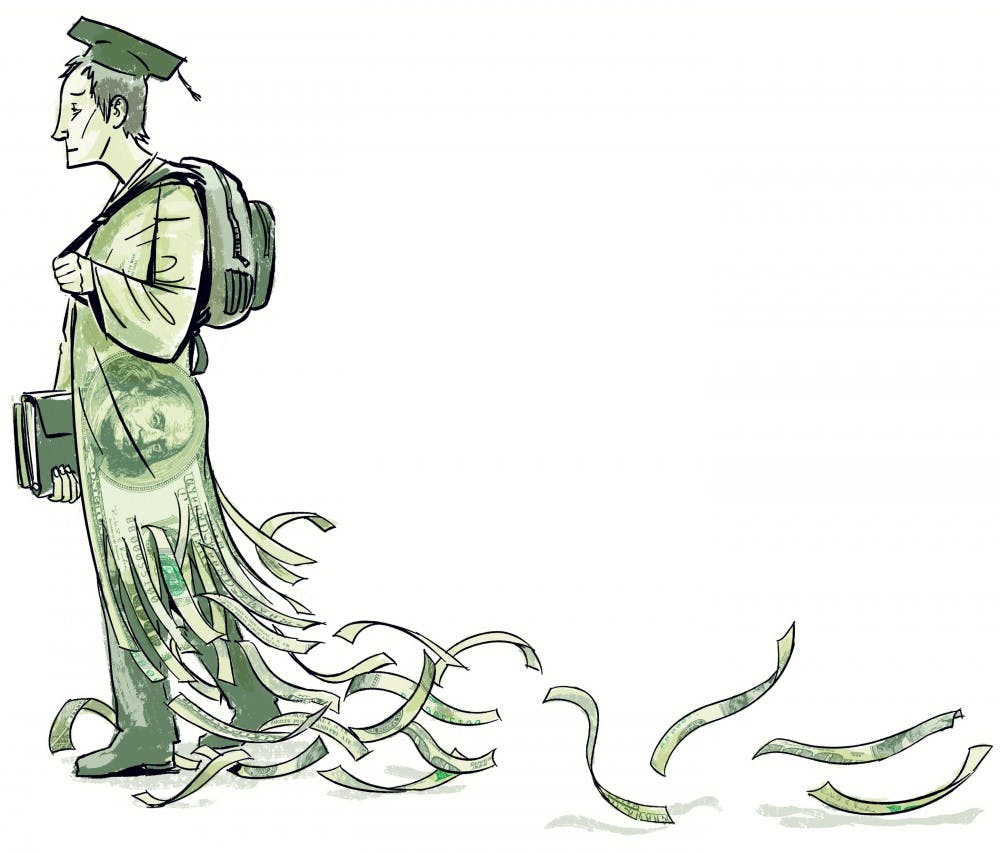Total Annual Cost (2013): $21,101 (in-state including tuition, books and living expenses)
Low-Income Students Paid: $9,178 (in-state per year, on average)
Discount: 57% off the total cost, per year
Median Federal Debt (All): $25,000
Median Federal Debt (Pell Students): $20,250
Source: Debt by Degrees
The Pell Grant provides aid to many Ball State students and helps them avoid debt, and about a third of students received the grant during the 2013-2014 school year.
Although loans are always an option, many students also look for grants or scholarships, which don’t have to be paid back.
The Pell Grant is a federal grant for college students. The amount of money students receive is based on the expected family contribution calculated by the FAFSA and how much tuition costs. Because the Pell Grant is based on income, some students don’t qualify at all.
According to College Navigator, 38 percent of freshmen at Ball State received a Pell Grant in the 2013-2014 school year. The average amount of aid for freshmen was $4,464. Thirty-four percent of all undergraduates in 2013-2014 received a Pell Grant. The average amount of aid for all undergraduates was $4,473.
Not everyone receives a Pell Grant right away. This was the case for Konnor Miller, a sophomore telecommunications major, who is only in his first year as a grant recipient. Even then, Miller doesn’t fall very high on the sliding scale; he receives $363 a semester.
“I still have to get help from my parents,” Miller said. “I was surprised I qualified this year because I didn’t last year. I still have to pay a lot of tuition though.”
Ericka Lange, a sophomore biology major, has qualified for the Pell Grant both of her years at Ball State. The grant is extremely helpful in paying for her education, she said.
“I did not have to take out loans thanks to the grant as well as other scholarships,” Lange said.
Some schools actively recruit low-income students, but Ball State is not one of those schools. The office of admissions has no idea what students’ financial need is when looking at applications, said John McPherson, assistant vice president of enrollment services.
“Students are admitted solely on their credentials,” McPherson said. “Admissions has no financial data or anything on a student. It’s good because it's all fair, not discriminatory to anyone.”
According to Debt by Degrees, Ball State gives a total tuition discount of 57 percent to low-income families. This means students from low-income families paid an average of $9,178.
Graduates who receive a Pell Grant had a median federal debt of $20,250. Those who don’t receive any money from the Pell Grant had a median federal debt of $25,000, according to the site.
Students’ debt can fluctuate if the amount they receive changes from year to year. For Lange, the amount she receives keeps her debt at a manageable amount.
“I should not have much debt as long as my amount for the Pell Grant stays the same,” Lange said.
In addition to the Pell Grant, Indiana residents are eligible for the Frank O’Bannon Grant. The O’Bannon Grant is determined the same way the Pell Grant is; a sliding scale based on the expected family contribution and tuition of the university.
There are certain requirements students must meet each year in order to keep the maximum award. For example, O’Bannon recipients must complete a certain number of credit hours each year. However, Lange said it’s not extremely difficult to meet the requirements.
Ball State also has its own grant for students who need financial aid, called the Ball State University Grant. This grant awards students a percentage of their financial need. A student’s need is determined by taking the cost of tuition and subtracting the estimated family contribution. The amount the student is receiving from other grants is also subtracted.
“We can’t meet all of a student’s need, but we try to meet a percentage,” McPherson said. “How much money a student receives depends on how much need is out there and how much money Ball State has to give.”
Miller has received other scholarships from Ball State, helping with the amount of debt he will have at graduation.
“I should be able to pay off my student loans in the normal amount of time,” Miller said.
One negative statistic for Pell recipients is their loan repayment rate. The non-repayment rate is a new measure, which includes “all students who are unable to pay off any of the principal on their student loans.” For Pell recipients, the number is 20.6 percent, while for non-Pell recipients the number is 15.5 percent. These numbers are based off a three-year rate on federal loans only.
Another negative statistic is the graduation rate of Pell recipients versus non-Pell recipients. The graduation rate within six years of Pell recipients (50.8 percent) was lower than that of those who didn’t receive a grant (59.4 percent).
In order to increase retention rates, freshmen and sophomores on the Pell Grant also have an opportunity to earn rewards through the Ball State Achievements app. According to a previous Daily News article, the app was designed to keep students academically and socially involved.
In a previous interview with the Daily News, vice president for student affairs Kay Bales said, “[Students using the app] earned higher grade point averages, higher number of credit hours than students who did not use the app.”
Students have downloaded the app more than 900 times. Lange said she hopes Ball State continues with the app.
“I think the achievements app is a great way to reward students for getting involved on campus,” Lange said. “It motivates me to go and attend new events that I might not have thought about trying before. The rewards are actually worth the time and effort.”
Miller also likes the app and its rewards.
“I love the achievements app,” Miller said. “I get rewards such as Ball State gear and technology for going to sporting events, Friday Night Filmworks and Late Nites that I already attended with my friends.”





